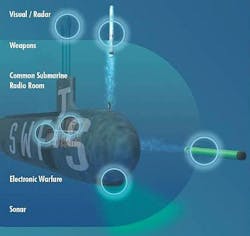Lockheed Martin to adapt submarine combat systems for network-centric warfare operations at sea
WASHINGTON, 15 April 2012. The Lockheed Martin Corp. Mission Systems and Sensors (MS2) segment in Washington is moving ahead with a U.S. Navy program to create common, open-architecture system-of-systems electronic designs aboard most Navy submarines to facilitate interoperability during joint operations with integrated fighting forces.
Lockheed Martin won a $21.9 million contract modification Friday for systems engineering and integration in support of the Navy's Submarine Warfare Federated Tactical Systems (SWFTS) program, which seeks to enable submarines to join integrated fighting forces in coastal areas and harbors, as well as in the open ocean. Awarding the contract are officials of the Naval Sea Systems Command in Washington.
SWFTS is composed of all submarine combat system subsystems, mainly consultation, command, control, communications, computers, and intelligence to provide for the overall architecture integration of submarine subsystems into one combat system for naval battle group interconnectivity.
The Submarine Warfare Federated Tactical System (SWFTS) is a system of systems composed of tactical and support subsystems, each of which is developed under an independent business model. SWFTS is the engineering umbrella to integrate and deliver these subsystems as one system.
SWFTS has become common to four of the five classes of submarines, enabling a cost reduction in maintaining independent systems and an increase in efficiency. SWFTS is an engineering and management program to allocate and test warfare requirements across subsystems, and is not an acquisition program.
SWFTS integration results when independent systems are integrated into a larger submarine system that delivers capabilities greater than the sum of the capabilities of the constituent parts. Separate systems retain individual program management.
The goal is to enable submarines to support network-centric warfare and join integrated fighting forces in coastal areas and harbors, as well as in the open ocean for battle group operations; strike warfare; intelligence collection and surveillance; indication and warning; electronic warfare; special warfare; mine warfare; anti-submarine warfare; and anti-surface ship warfare.
Previously, the Navy had five different combat systems on five different submarine classes -- the Los Angeles-class fast-attack submarine (SSN 688), the improved SSN 688, the Seawolf-class fast attack submarine (SSN 21), the Ohio-class cruise-missile submarine (SSGN 726), and the Virginia-class fast attack submarine (SSN 774).
The SWFTS program developed a common architecture for these five different classes of submarines based open architectures and commercial off-the-shelf (COTS) components and subsystems, which not only transformed submarines from stand-alone vessels to nodes in combat networks, but also saved hundreds of millions of dollars, Navy officials say. The SWFTS programs approach focuses on open system interface standards and widely available commercial computer resource products.
As a result, all Navy submarines except the Ohio-class ballistic missile submarines (SSBN 726) contain the same basic set of subsystems and information architecture with some variations to accommodate different sensors and mission capabilities.
The SWFTS program has installed external Internet protocol (IP) communications capability aboard Navy attack and cruise-missile submarines to enable network-centric strike, anti-submarine warfare, intelligence and reconnaissance, special operations, and anti-ship missions.
IP capability also enables chat, e-mail, and web services to exchange information among submarine crew members and mission stations with several different security levels, based on the sensitivity of the missions at hand the subsystems being used.
The SWFTS net-centric design approach serves to enhance interoperability among joint forces and the combatant commanders by enabling authenticated, trusted, and verified information to be shared among authorized users, applications, and weapon systems.
For more information contact Lockheed Martin MS2 online at www.lockheedmartin.com/us/ms2, or Naval Sea Systems Command at www.navsea.navy.mil.
